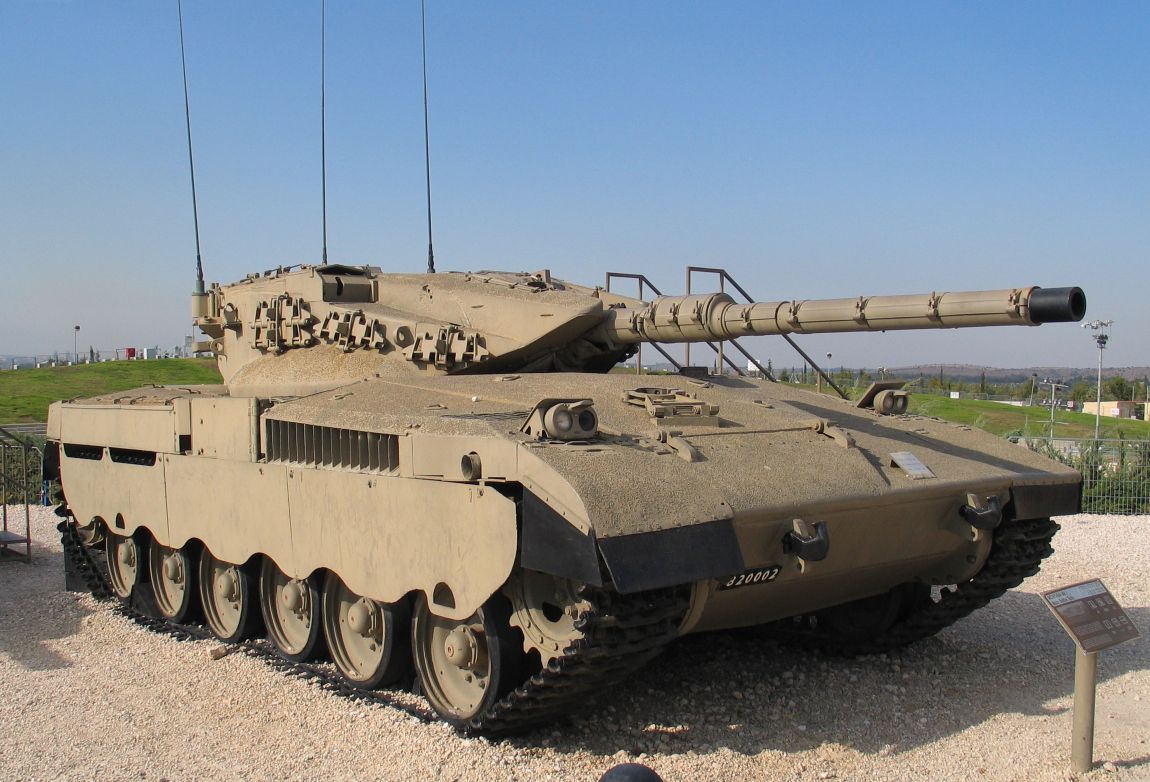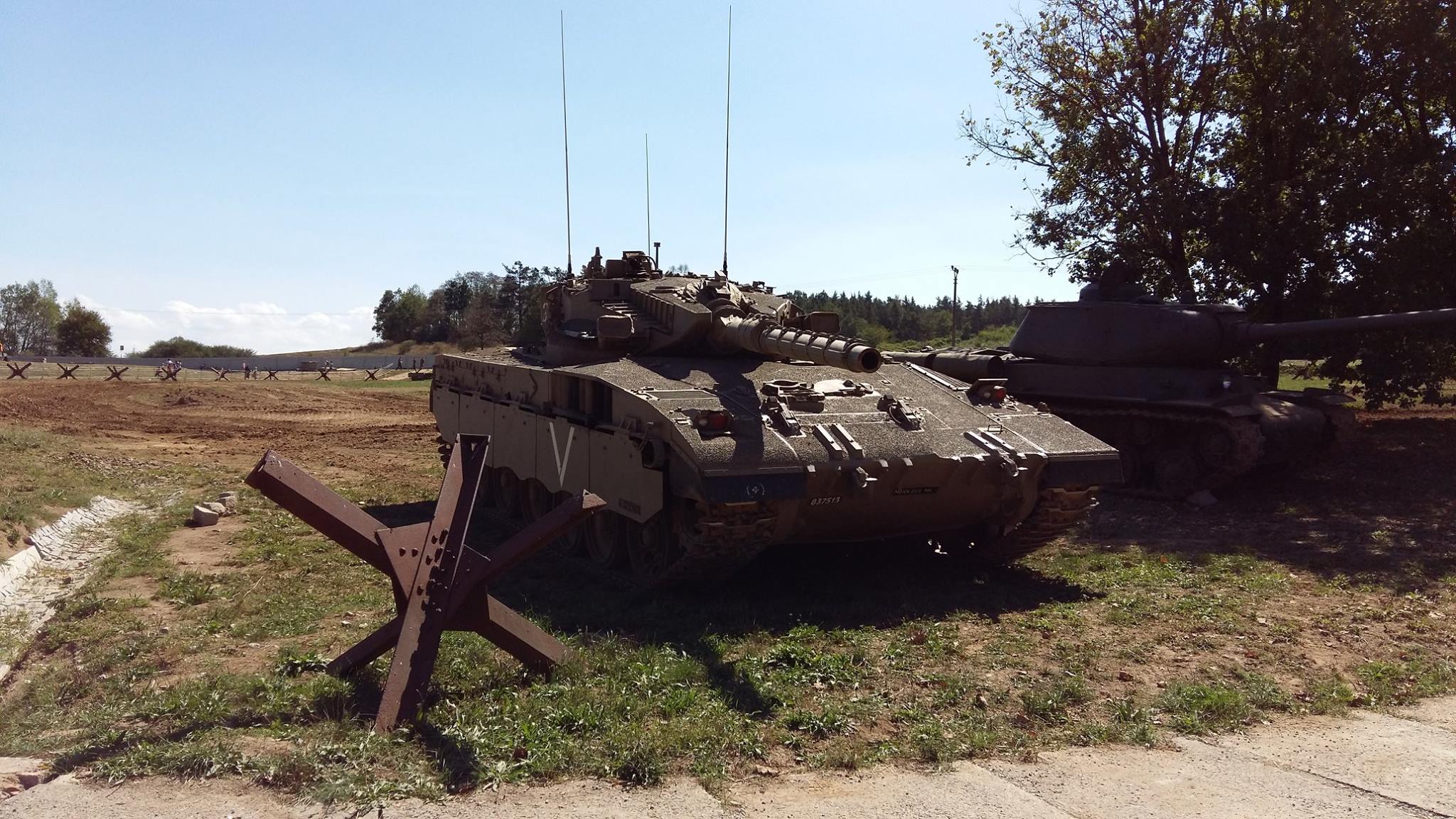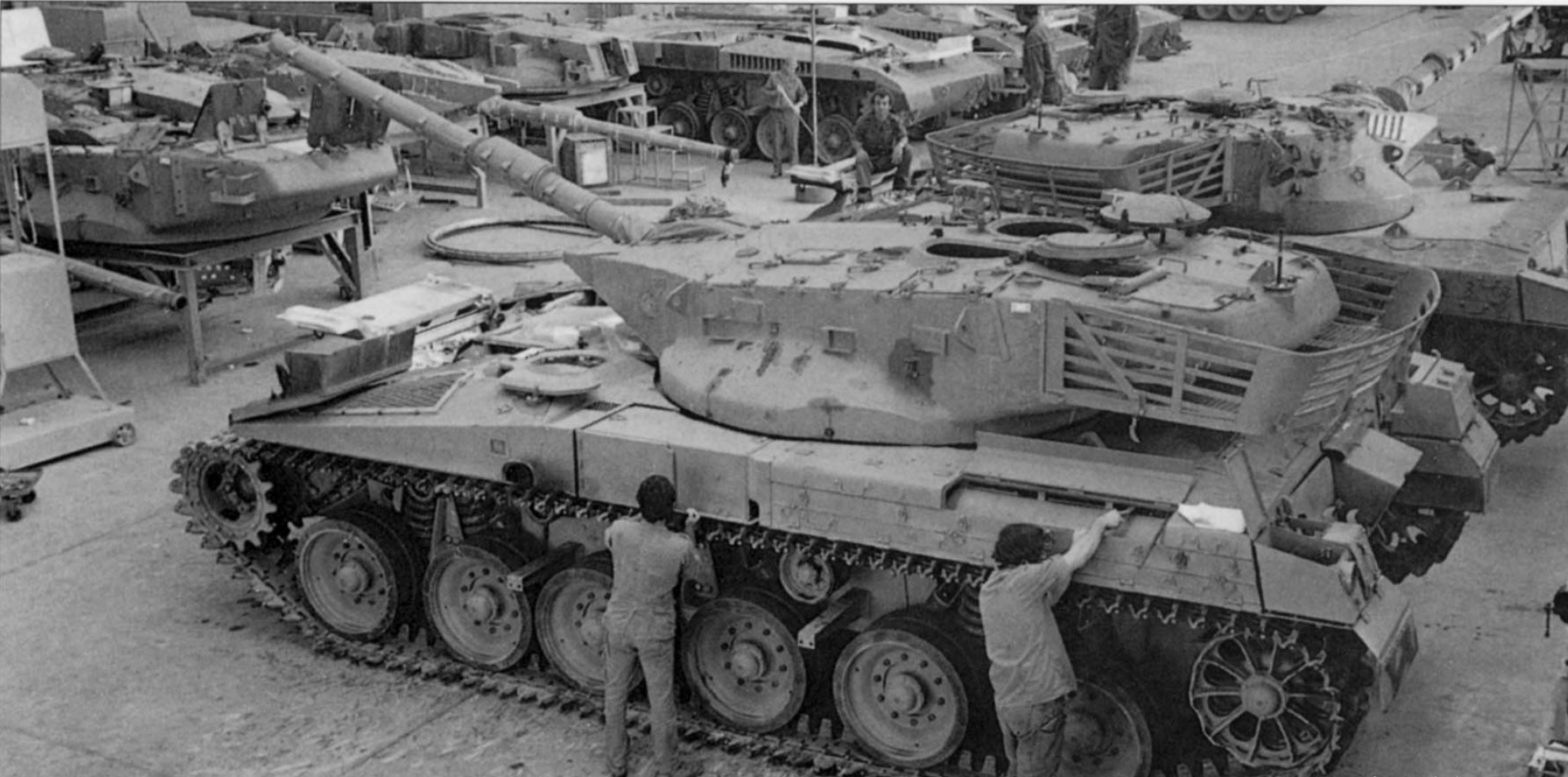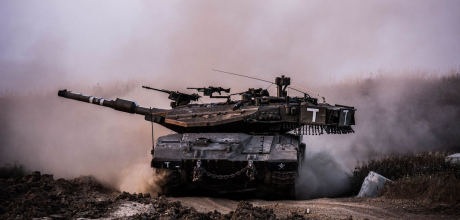
Commanders!
Today, we are happy to unveil the first of the progression tanks you’ve all been waiting for, which form the core of the upcoming Israeli MBT branch – the Merkava series, starting with the Tier 5 Merkava Mk.1 Main Battle Tank.

Merkava Mk.1
The Merkava certainly has an interesting history – if often misinterpreted. Over time, it became for the modern tank fans what the Tiger Heavy Tank is for the fans of German Second World War tanks – an incredibly overhyped vehicle that was actually far more modest than most people think it was.
Many would tell you that its development was a direct result of the high losses the Israelis had suffered during the 1973 Yom Kippur war. Afterwards, the talented Israeli engineers came up with a completely original Israeli super-tank that was vastly superior to anything on the battlefield and was even capable of carrying entire squads of IDF soldiers to battle.
In reality, almost the entire abovementioned perception is wrong. The initial Merkava model was essentially comparable to the two decades older M60A1 in performance (that is, without taking the teething issues it faced into account) and most internal modules of this “all-Israeli” tank were American. That, of course, doesn’t mean it was a terrible tank – it was not, but one must strip away the layers of legend surrounding all the Israeli equipment to learn the objective truth.
The launch of the Merkava development program pre-dated the Yom Kippur War by three years (the development started in August 1970) and was not motivated by high losses – quite the opposite. By that time, the Israeli public was still in awe of the stunning 1967 victory, which led, for one, to disproportionate preference of the Israeli Air Force and, secondly, to complacency and corruption. After all, if the entire hostile Arab world could be knocked out in mere six days, surely any future attacks were destined to fail. The reasons for the Merkava program were thus different.
From the earlier articles we’ve published on the development of Israeli tanks, you can trace a clear pattern – up until the early 1970s, Israel was never really able to procure a large (or even sufficient) number of modern tanks for both political reasons and because of their prohibitive costs. Firmly establishing itself as an ally to the west, purchasing Soviet arms was obviously not an option and while some of the Arab Russian-made MBTs, after being captured in battles, were operated by IDF crews, they were not really all that well received.
On the other hand, Britain and France were fickle allies at best, always pursuing their own interests in the Middle East, as demonstrated by the 1967 Israeli attempt to purchase the Chieftain MBTs from the British. That left only two major and reliable sources of armor – West Germany and the United States of America. The German-Israeli cooperation, as awkward as it was, proved to be a major source for modern equipment with the Germans sometimes acting independently to the point where the U.S. didn’t know about it and sometimes as an American proxy.
The United States, too, had their limits, unwilling to provide Israel with large amounts of modern armor in order not to provoke the Soviets into escalating the Middle East excessively. This strategy did not work (the Soviets provided their Arab allies with massive amounts of modern weaponry anyway) and was only turned around in the 1970s, especially during the Yom Kippur war when it was, amongst other things, large amounts of American supplies that saved Israel from annihilation.

Merkava Mk.1
But that was all in the 1970s. Simply put, during the Israeli armor discussions of the 1960s (the first ideas to produce an indigenous tank appeared around 1962), Israel came to a conclusion that there was no reliable source of modern armored vehicles and the best thing would be to build an Israeli tank for their own needs. The decision was, of course, a political one as well, capitalizing on the 1967 experience – the public tends to regard major military spending more favorably after practically all your neighbors attack you, especially when the said spending involves a production of an indigenous armored vehicle – an armored shield of Israel.
Only, there were several problems with that.
For one, Israel had nowhere near the level of industry required to make such a thing happen quickly. It’s not like everything had to be built from scratch – there were plants converting older vehicles to upgraded ones, of course, but making an entirely new tank would be a different beast entirely when compared to improving the old Israeli Centurions, for example.
Secondly, this required quality armored steel – and a lot of it. Things as basic as casting procedures had to be developed from scratch. Here’s where Israel’s relatively close ties to South Africa came in handy. The military cooperation between the two countries was a close one with the South African Olifant tanks (upgraded Centurions) were in their initial upgrade stage basically Israeli Sho’t Kals. In return, the South African ore was available for purchase. It’s worth noting that Israel later even offered South Africa the chance to buy the Merkava 1 for 810.000 USD each, but South Africa declined.
And last but not least, there were the internal components. It would make no sense for Israel to develop everything indigenously – licensed local production of existing parts or their import (usually much easier logistically and more politically acceptable than the import of entire tanks for the selling party) was a far more viable solution and with the politics described above in place, there was only a single logical conclusion left: the guts of the new tank would almost entirely be American. Even then, it would an incredible feat to set up a component production on such a level.
Despite these obstacles, it was still decided to proceed with the endeavor and the development of what would become the Merkava started on August 20, 1970 under the command of General Israel Tal.
The best word to describe Israel Tal would perhaps be “visionary.” A man of small stature but amazing skills, he was mostly responsible for the creation of the successful Israeli armor doctrine, emphasizing long-range gunnery over slugging it out with the enemy at close range, leading to the successes of the Six-Day War.
Yet, during the course of the Merkava development, sometimes his ideas were too innovate for the Israeli industry level – that’s where Colonel Yisrael Tilan came in, to keep him grounded. Yisrael Tilan was the chief engineer of the Merkava program and another major reason it succeeded. The goal of the program was simple – it wasn’t to create a “wonder weapon” but, instead, a sufficient indigenous MBT based on available and tested components.
Several designs and wooden mockups were completed in 1970, some of which featured a wooden Merkava-like structure added to a Centurion chassis. Early testbeds and prototypes were completed in 1970 using heavily modified Centurion hulls. One such prototype even used an M48 or M60 turret during testing.
In any event, first four finalized prototypes were ready by 1974 and the Merkava Mk.1 entered official production in April 1979. By the time the first production tanks rolled from the assembly lines, the program costs climbed to some 65 million USD and it involved roughly four and a half thousand people. The first fully equipped battalion of 30 tanks was operational starting from 1980.

Merkava in construction
Mind you, these tanks were not “finished” in the strictest sense of the world. Israel only had limited resources and the Merkava Mk.1 production run was something basically an equivalent of the western pre-production series concept where remaining kinks and flaws were ironed out during the deployment of the vehicle. In this sense, only the Merkava Mk.2 was a “true production” model with its initial teething issues fixed.
But what kind of a tank was the Merkava?
Perhaps the most often brought up goal of the Merkava program was the protection of its crew. It wasn’t the main goal, but it was certainly a consideration. However, without the access to such modern western features as the British Chobham armor, the Israelis had to improvise in order to achieve it.
One of the earliest Merkava program features was putting the engine (as well as other components) to the front of the vehicle – that way it offered an extra layer of protection. The importance of this is arguable and possibly even overestimated, but it certainly is one of the defining traits of any Merkava. The engine is not made of ballistic materials like the steel used in armor. Engines are made to be as light as possible, making good use of metals like aluminum and other lightweight metals to keep the weight down and the amount of protection offered against kinetic rounds is negligible.
Either way, crew protection is something General Tal clearly believed in – after all, it was his people putting their lives on the line. This solution wasn’t, however, without its disadvantages that included:
- Weight distribution issues and their effect on mobility (the initial Merkavas were “nose-heavy”)
- Frontal engine, as a major heat source, affected Merkava’s thermal optics (for later variants)
- For the same reason, the hot engine was a massive target for heat-seeking ATGMs
- Reduced gun depression due to the turret being shifted more to the back (not to poor Soviet values, but the Patton series was better)
- Somewhat worse access to the engine (one has to go through thick plates of armor instead of just a thin engine deck)
The second feature was its distinctive wedge-shaped armor, optimized to deflect incoming kinetic shells that were perceived as a serious threat to any tank, just like the ATGMs and RPGs. This also reduced the tank’s frontal silhouette, making it harder to hit.
The third major feature was its combat sustainability. The space in the back, formerly occupied by the engine, was used for other purposes (ammunition storage). The tank thus carried more ammunition than its contemporaries and was able to shell the enemy for longer periods of time and could also be reloaded quickly from the outside using the door in its rear armor. Alternatively, this ammunition could be cleared out, making space for general troopers that the tank could carry but, contrary to popular belief, it could not have acted as an actual troop carrier – this was an emergency solution at best.
Perhaps the biggest disadvantage of the Merkava Mk.1 was that it was heavy – really, really heavy. Compared to the 48 ton M60A1, the Merkava weighed whole 60 tons. This had a significant impact on its mobility.
It was powered by a 900hp variant of the Continental AVDS-1790 V12 diesel (AVDS-1790-6A) paired with an older Allison CD-850-6 transmission – the same type of engine was standardized in the IDF and the Magach and Sho’t tanks used it as well. The transmission, however, was neither designed for this kind of engine power, nor for the tank’s weight and caused reliability issues.
The maximum speed of the Merkava Mk.1 was also not very high (perhaps some 45-50 km/h with a rather slow acceleration value), but that was considered secondary – no tanks move often using their maximum speed, after all. The suspension was of the Horstman type used on the Centurion and Chieftain MBTs – the Israelis were at that point very familiar with it.

Merkava Mk.1
When it comes to Merkava’s armor, it consisted of steel plates (not composites – that came later), designed and installed under such angles as to be quite effective versus enemy kinetic penetrators.
However, that does not mean the armor of the Merkava Mk.1 was thick – quite the opposite. Special care was taken to not have the crew suffer from the issues of the Magach (like being subjected to a burning hydraulic fluid shower), but the actual armor was quite thin. Portions of the upper deck and engine cover (the engine plate is entirely removable) were only 20-30mm thick. The entire front right side of the Merkava hull (alongside the engine) was also entirely devoid of armor to fit in components related to the engine itself.
The turret wasn't well armored either. The spaced armor made by welding steel onto the base turret does sound wonderful in theory, but there's something else that usually goes unnoticed: the trunnions for the gun mounted within the "spaced" armor welded onto the turret. Even if the incoming enemy round did not penetrate into the cast turret itself, a round near the front of this spaced armor could result in the gun being jammed in place. And last but not least, there was that rear turret shot trap that had to be remedied by the now-famous “hanging chains” device.
It’s worth noting that the Merkava Mk.1 was never upgraded with the Blazer ERA kit. The reasons for this step are debatable, possibly pointing out to the fact that the underlying armor was not thick enough as to structurally support it.
All in all, what this means is that:
- The basic protection of the Merkava Mk.1 was quite poor, comparable to the Patton series
- However, when knocked out, the crew had a considerably higher chance of survival
- The crew then bailed out and the vehicle could be recovered
Additional protection was provided by:
- NBC overpressure system
- Smoke generator (by injecting its diesel fuel into the exhaust, creating a curtain of thick white smoke)
And finally, we come to the last piece of the puzzle – Merkava’s firepower. It was armed, much like the other Israeli tanks, with a 105mm rifled gun (license produced American M68 with a Vidco thermal shroud). The gun was manually loaded (the tank had a crew of four) with 6 rounds in a ready rack and another 56 rounds elsewhere in the hull.
The gun was fully stabilized (Cadillac-Gage stabilization), could elevate to +20 degrees and depress to -8.5 degrees. It was controlled by the Matador FCS, consisting of:
- Laser rangefinder
- Digital computer
- Cross-wind sensors
- Infra-red and day optic sights
It’s worth noting that the Merkava Mk.1 was not equipped with a thermal imager. Additionally, the tank was armed with a turret-mounted 60mm Soltam mortar, operated by the vehicle’s commander. The mortar proved to be very useful against enemy anti-tank teams and lighter fortified positions.
By the time of the 1982 Operation Peace for Galilee (the Lebanon War), perhaps 200 Merkava Mk.1 tanks were in service with some participated in the fighting. The actual combat record is not entirely known, although some sources claim that the Merkavas knocked out a bunch of Syrian tanks (likely T-62s) during the fighting. Several tanks were lost, mostly to enemy RPGs. The important part was that, however, that only a low number of crewmembers suffered wounds upon penetrations.

Merkava Mk.1 knocked out in Lebanon
In this sense, the first combat deployment of this vehicle was a success and proved that the millions of USD poured into its development were not wasted. What the Israelis got was a reasonable (if rather expensive) Main Battle Tank on par with or better than their modified Patton series that (despite suffering from some initial issues) would only get better.
In Armored Warfare, the Merkava Mk.1 will be an Israeli Branch Tier 5 Progression Main Battle Tank. The Merkava Mk.1 marks a departure from the Sho’t and Magach long-range sniper gameplay. For its Tier, it will offer above average protection and the highest hitpoint count on its Tier, making it an ideal front-line fighter, capable of shielding its allies from practically any threat. Additionally, its 105mm gun will feature a 4-round Ready Rack (even though the other gun values will mostly be average).
On the downside, it will be the slowest and least mobile accelerating MBT of its Tier – careful positioning will be essential when considering your next course of action, as you will not be able to rely on your speed or acceleration to get you out of trouble.
We hope that you will enjoy it and will see you on the battlefield








